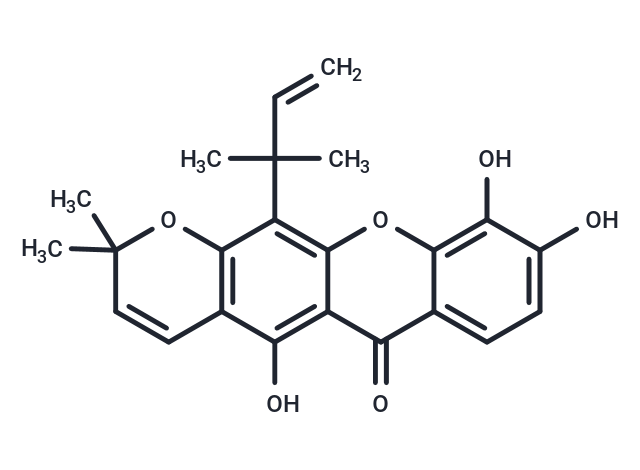Shopping Cart
Remove All Your shopping cart is currently empty
Your shopping cart is currently empty
Macluraxanthone (3-Hydroxyblancoxanthone) has many biological activities including anticholinesterase, antioxidant, anticancer, antimalarial, anti-inflammatory and immunomodulatory effects. macluraxanthone promotes the polarization of M1-like pro-inflammatory macrophages by increasing the percentage of macrophages expressing CD86 while decreasing their expression of CD14, CD11b and CD80. Macluraxanthone significantly reduced the production of TNF-α and IL-10 cytokines in the presence of the pro-inflammatory stimulant lipopolysaccharide.

| Pack Size | Price | USA Warehouse | Global Warehouse | Quantity |
|---|---|---|---|---|
| 5 mg | $1,589 | Inquiry | Inquiry | |
| 1 mL x 10 mM (in DMSO) | $1,898 | Inquiry | Inquiry |
| Description | Macluraxanthone (3-Hydroxyblancoxanthone) has many biological activities including anticholinesterase, antioxidant, anticancer, antimalarial, anti-inflammatory and immunomodulatory effects. macluraxanthone promotes the polarization of M1-like pro-inflammatory macrophages by increasing the percentage of macrophages expressing CD86 while decreasing their expression of CD14, CD11b and CD80. Macluraxanthone significantly reduced the production of TNF-α and IL-10 cytokines in the presence of the pro-inflammatory stimulant lipopolysaccharide. |
| In vitro | Macluraxanthone (3 and 10 μM), at non-toxic effective doses, significantly inhibited B16F10 cell invasion, to a greater extent than 10 μM doxorubicin, while reducing migration of cancer cells without cellular cytotoxicity. Our findings indicate for the first time that active macluraxanthone isolated from Maclura amboinensis Bl. roots affect multistep of cancer metastasis processes including proliferation, adhesion, invasion and migration, possibly through induction of apoptosis of highly metastatic B16F10 melanoma cells.[1] |
| In vivo | We investigated the in vivo therapeutic effects of the two xanthones in a xenograft murine model of human CLL, developed by engrafting CD5-transfected chronic leukemia B cells into SCID mice. Treatment of the animals with five daily injections of macluraxanthone (5 mg/kg) resulted in a significant prolongation of their survival as compared to control animals injected with the solvent alone (p = 0.0006 and p = 0.0141, respectively). These data show for the first time the in vivo antileukemic activities of two plant-derived xanthones.[2] |
| Synonyms | 3-Hydroxyblancoxanthone |
| Molecular Weight | 394.42 |
| Formula | C23H22O6 |
| Cas No. | 5848-14-6 |
| Smiles | O=C1C2=CC=C(O)C(O)=C2OC=3C1=C(O)C=4C=CC(OC4C3C(C=C)(C)C)(C)C |
| Relative Density. | 1.329 g/cm3 (Predicted) |
| Storage | store at low temperature,keep away from direct sunlight | Powder: -20°C for 3 years | In solvent: -80°C for 1 year | Shipping with blue ice/Shipping at ambient temperature. |
| Size | Quantity | Unit Price | Amount | Operation |
|---|

Copyright © 2015-2026 TargetMol Chemicals Inc. All Rights Reserved.